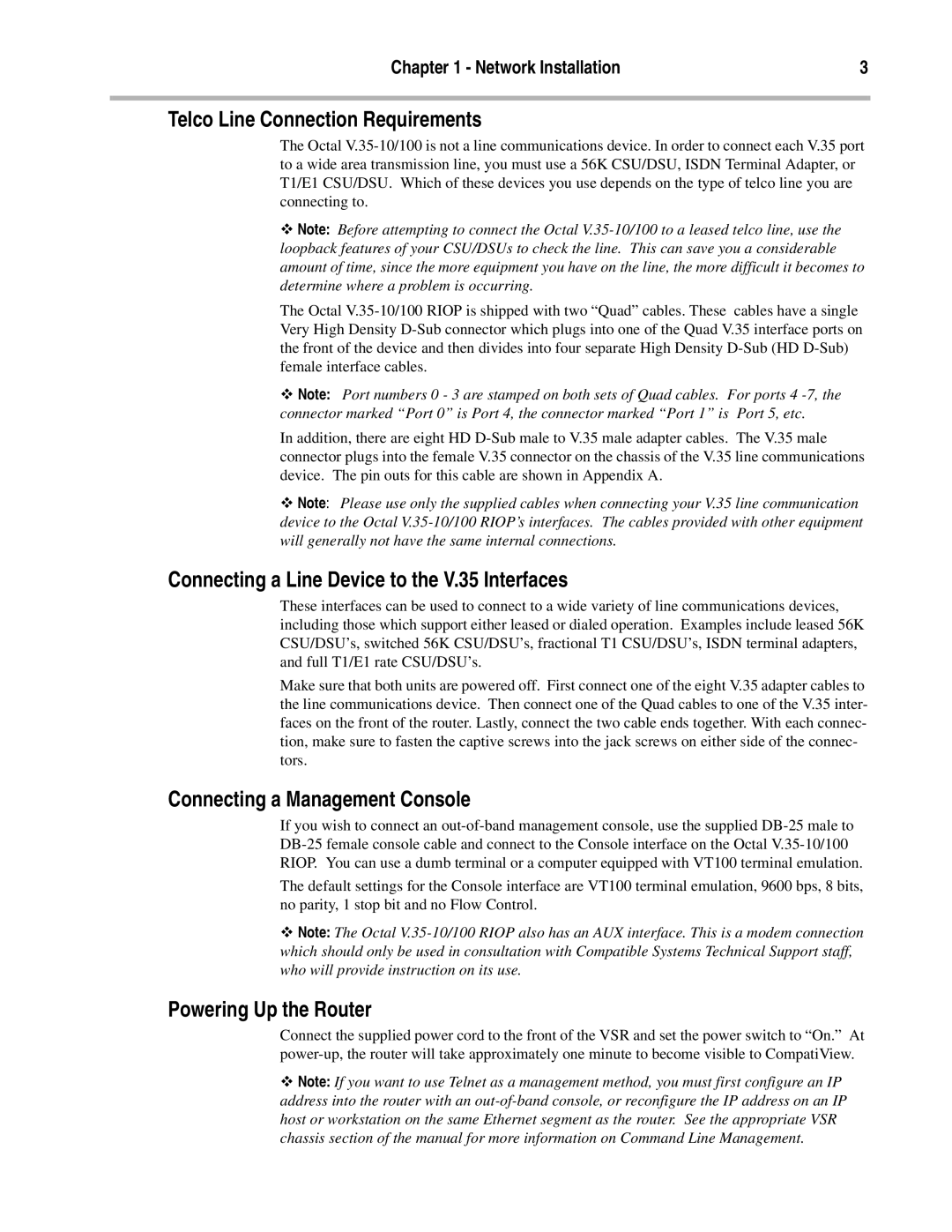Chapter 1 - Network Installation | 3 |
Telco Line Connection Requirements
The Octal V.35-10/100 is not a line communications device. In order to connect each V.35 port to a wide area transmission line, you must use a 56K CSU/DSU, ISDN Terminal Adapter, or T1/E1 CSU/DSU. Which of these devices you use depends on the type of telco line you are connecting to.
ϖNote: Before attempting to connect the Octal V.35-10/100 to a leased telco line, use the loopback features of your CSU/DSUs to check the line. This can save you a considerable amount of time, since the more equipment you have on the line, the more difficult it becomes to determine where a problem is occurring.
The Octal V.35-10/100 RIOP is shipped with two “Quad” cables. These cables have a single Very High Density D-Sub connector which plugs into one of the Quad V.35 interface ports on the front of the device and then divides into four separate High Density D-Sub (HD D-Sub) female interface cables.
ϖNote: Port numbers 0 - 3 are stamped on both sets of Quad cables. For ports 4 -7, the connector marked “Port 0” is Port 4, the connector marked “Port 1” is Port 5, etc.
In addition, there are eight HD D-Sub male to V.35 male adapter cables. The V.35 male connector plugs into the female V.35 connector on the chassis of the V.35 line communications device. The pin outs for this cable are shown in Appendix A.
ϖNote: Please use only the supplied cables when connecting your V.35 line communication device to the Octal V.35-10/100 RIOP’s interfaces. The cables provided with other equipment will generally not have the same internal connections.
Connecting a Line Device to the V.35 Interfaces
These interfaces can be used to connect to a wide variety of line communications devices, including those which support either leased or dialed operation. Examples include leased 56K CSU/DSU’s, switched 56K CSU/DSU’s, fractional T1 CSU/DSU’s, ISDN terminal adapters, and full T1/E1 rate CSU/DSU’s.
Make sure that both units are powered off. First connect one of the eight V.35 adapter cables to the line communications device. Then connect one of the Quad cables to one of the V.35 inter- faces on the front of the router. Lastly, connect the two cable ends together. With each connec- tion, make sure to fasten the captive screws into the jack screws on either side of the connec- tors.
Connecting a Management Console
If you wish to connect an out-of-band management console, use the supplied DB-25 male to DB-25 female console cable and connect to the Console interface on the Octal V.35-10/100 RIOP. You can use a dumb terminal or a computer equipped with VT100 terminal emulation.
The default settings for the Console interface are VT100 terminal emulation, 9600 bps, 8 bits, no parity, 1 stop bit and no Flow Control.
ϖNote: The Octal V.35-10/100 RIOP also has an AUX interface. This is a modem connection which should only be used in consultation with Compatible Systems Technical Support staff, who will provide instruction on its use.
Powering Up the Router
Connect the supplied power cord to the front of the VSR and set the power switch to “On.” At power-up, the router will take approximately one minute to become visible to CompatiView.
ϖNote: If you want to use Telnet as a management method, you must first configure an IP address into the router with an out-of-band console, or reconfigure the IP address on an IP host or workstation on the same Ethernet segment as the router. See the appropriate VSR chassis section of the manual for more information on Command Line Management.
